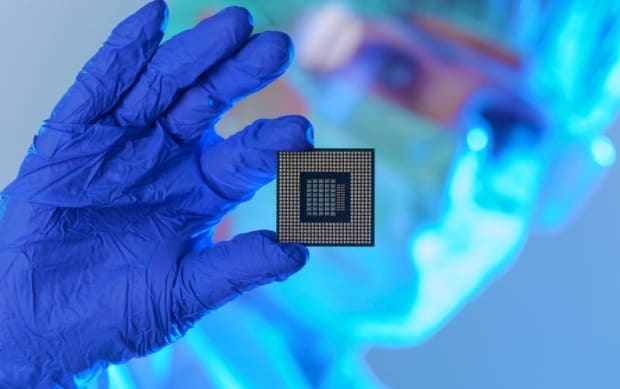The semiconductor sector bounced back during the past week as news from Samsung buoyed the market, but faces more headwinds amid high inflation dampening consumer demand and supply chain challenges.
Some semiconductor stocks rose by as much as 6% as the market priced in a strong earnings season.
Samsung's stock rose by over 3% on July 7 after the company said it estimated second quarter revenue to increase by rise 22% year over year to 77.78 trillion Korean won ($59.8 billion), meeting expectations.
The Japanese chip maker's operating profit is anticipated to rise by 12% to 14.12 trillion Korean won, which missed expectations and is the slowest increase in two years.
Samsung's results were “better than feared,” SK Kim, analyst at Daiwa Capital Markets, told CNBC.
Micron ((MU)) has warned Wall Street that demand for consumer products is waning.

Why Semis Are Cheap Right Now
The slump that semiconductor companies fell into also pushed down their valuations by over 35%.
“Semis as a group have become too cheap,” Thomas Hayes, chairman of Great Hill Capital in New York, told TheStreet. “If you dig under the surface there is value to be had with a one to three year view.”
The sector became a “victim of their covid year of success,” Steve Sosnick, chief strategist of Interactive Brokers, a brokerage based in Greenwich, Conn., told TheStreet.
“The market was pretty much paying for growth at any price and semis got caught in that enthusiasm,” he said.
Semiconductor companies have given a lot back from their peak with companies dipping by an average 35%, he said.
Investors who bought semiconductor stocks in March 2020 or even last November, received gains in their holdings.
“It is a matter of perspective,” Sosnick said. “You are still doing fine if you had been investing in semis all along.”
As the use of technology becomes more commonplace, the use of semiconductor chips is increasingly a component of any finished goods that consumers buy, he added.
“Fundamentally, if you look at semis, this is a sector that warrants our attention under all circumstances,” Sosnick said.
While many semiconductor stocks are “way off their highs,” companies such as Advanced Micro Devices (AMD) or Qualcomm (QCOM) are growing at a good pace, Sosnick said.
Both AMD and Qualcomm’s estimated price-to-earnings ratio are in their teens and not high compared to historical standards while Intel (INTC) remains a “problem child of the sector” because of a patterns of earnings disappointments, he said.
Outlook for Semis in Second Half
Companies that make semiconductor chips for lower end consumer products such as PCs and smartphones such as Intel are “hurting really bad,” Angelo Zino, an equity analyst at CFRA, a New York-based investment research company, told TheStreet.
NXP Semiconductors (NXPI) and ON Semiconductor (ON) whose chips are used in the automotive industry, data centers and industrial sector hold up better, he said.
“History says you want to follow the semiconductor content growth because when they come out of down cycles, you will see the most powerful moves to the upside,” Zino said.
The average semiconductor stock is down 35% to 45% on average from their peak at the end of 2021 with valuations down by 40% to 55%.
“The decline we have seen from the December high is both the longest tenured and steepest in decline since the Great Recession,” he said. “A lot of damage has been done on the valuation side.”
The Street will often “overcorrect and punish these names ahead of a semiconductor down cycle and is what you have seen in the pricing side,” Zino added.
Stocks such as Microchip (MCHP), which makes microcontrollers and analog chips, Texas Instruments (TXN) and OnSemi have all faced supply constraints and have been among the “biggest pain points” with their stocks falling by 33.2%, 19.3% and 24.5% year-to-date respectively, Zino said.
“Micron set a good job lowering the bar and flagged the biggest concerns in the market for consumer driven end markets,” he said.
AMD is a “tougher play,” and is more challenging because it sells chips that perform the main computing for PCs and servers and has been impacted by oversupply and competitor threats as Nvidia (NVDA) targets CPU data center servers in 2023,” Zino said.
“We like AMD’s story, but it is not as much a slam dunk as it was one to three years ago,” he said.
Nvidia receives substantial revenue from its chips that are used in data centers and also receives a good percentage of sales from more consumer-oriented markets, which is being pressured by weakness on the gaming side, he said.
“The story for them is data centers and that they are expected to see significant penetration into the automotive landscape and are rolling out new offerings in 2023 such as CPUs,” Zino said. “The long-term opportunity is excellent for them.”
Nvidia’s high multiples were driven by consumer interest in gaming and crypto and those areas may be subdued for some time, Hayes said.
“I have less interest in NVDA, but “would never bet against Nvidia CEO Jensen Huang,” he said.
Intel will likely continue to lose market share to AMD and Nvidia, Zino said. Even though Intel generates enough cash to fund its foundry expansion, it will take the company a couple of years for the transition to play itself out, he said.
Companies like NXP Semiconductors, Onsemi and Microchip that make microcontrollers and power management chips for the automotive industry will continue to be constrained into the second half of the year, Zino said.
“We do expect many of the supply constraints and pain points in the market to considerably ease by the first half of 2023,” he said.
Taiwan Semiconductor Manufacturing Company (TSM) has the lion’s share of the automotive chip business, Hayes said.
“With auto dealer inventories at historic lows, a huge backlog of new car demand and the average age of the U.S. car and truck fleet at 13.1 years, demand will be robust for years to come,” he said.
The semiconductor sector will see “considerable” improvement since the assembly plants in China are now starting to ramp up production, Zino said. Demand in chips will also start to taper as supply is “coming back and will have a more normalized demand landscape playing itself out in the next couple of quarters.”
Investors should never buy them “all at once because you never know when the bottom comes in at a cycle,” he said.
Instead, investors should purchase the stocks after the first round of earnings cuts because “you are typically rewarded and stand to make a lot over time,” Zino said.
Semiconductor stocks have sold off more than the broader market in many instances, but investors could “make a real argument” that there are many companies offering growth at a reasonable price, Sosnick said.
“This is what investors have been seeking for many years,” he said. “There are values in this sector.”







